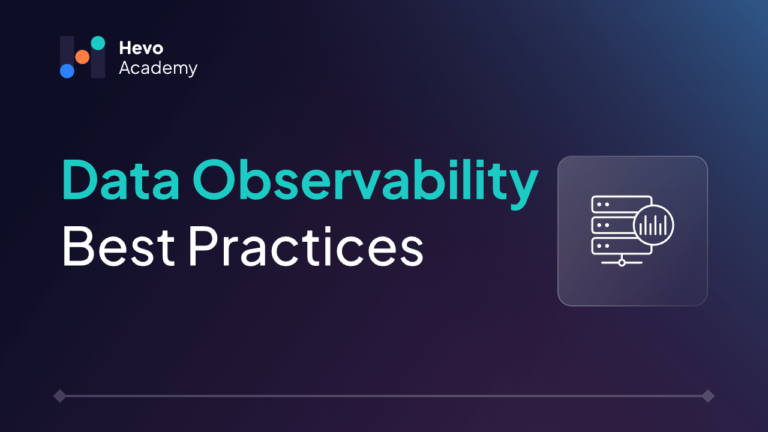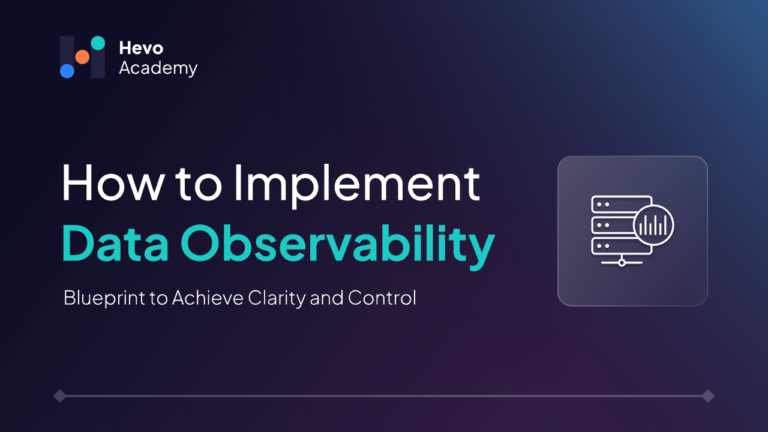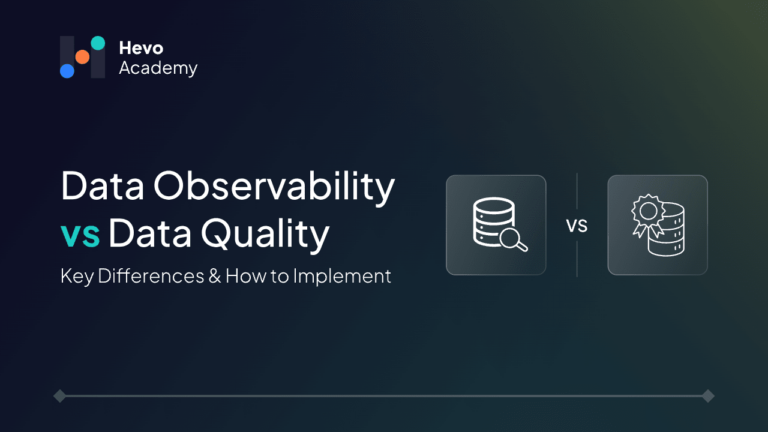The world today is information-driven; it follows that quality and reliable data need to be ensured. The increasingly complicated nature of data flows and architectures increases the challenge of guaranteeing data quality. This comes with the help of data observability tools. Such tools provide insights into the quality and freshness of the data and highlight anomalies therein.
Table of Contents
Such tools alleviate the responsibilities of the data team in tackling a problem ensuring reliable data access. In this article, we’ll discuss data observability and some of the top data observability tools that can enhance data quality and operational efficiency for your business.
What is Data Observability?
Data observability is the process of monitoring, tracking, and ensuring the health of the data that is flowing through the company’s systems and pipelines. It provides data teams with early insights to ensure data quality is maintained during data transfers. The Data Observability framework is built on five pillars: freshness, volume, distribution, schema, and lineage.
These pillars allow data teams to check if the data is up to date, monitor volumes of data to check if any record is missing, track data distribution patterns, validate schema changes, and track data lineage across systems and pipelines. With the help of these pillars, data observability ensures there are no anomalies and missing or duplicate records. To sum it up, Data observability empowers organizations to believe that their data is reliable and has high data quality.
Need for Data Observability Tools
- Detailed Insights- Data Observability tools provide detailed insights into why issues occur.
- Data Quality- Poor data quality can lead to inaccurate insights, which can further lead to costly business mistakes and decisions. Observability tools help to ensure data quality.
- Data Complexity – Nowadays, Companies have complex data workflows and ecosystems. Data observability tools help make it less complex.
- Data Governance and Compliance- Data Observability tools enhance compliance by ensuring data reliability, tracking changes, and alerting users to anomalies.
- Response Time- Data Observability tools Improve incident response time and uptime.
Top Data Observability Tools
1. Monte Carlo
G2 Rating: 4.5 out of 5 stars (267)
Monte Carlo is one of the top data observability tools that offers robust observability and is specifically designed to automate data monitoring. Monte Carlo primarily focuses on providing data reliability and quality. Its industry-leading features include anomaly detection, root cause analysis, and end-to-end data lineage.
Monte Carlo offers two types of pricing: pay-as-you-go or choose a usage plan to get a discounted price. The usage plan offers three tiers to choose from, i.e., Start, Scale, and Enterprise.
| Pros | Cons |
| Intuitve User Interface. Advanced-Data Lineage Capabilities.Provides Automated anomaly detection. | High pricing, Not suitable for small companies.Steeper learning curve for advanced features. |
2. Datadog
G2 Rating: 4.3 out of 5 stars (532)
Datadog is a modern data observability tool that provides AI-powered anomaly detection that allows issues to be solved at faster speeds. It provides a variety of monitoring options like contained monitoring, database monitoring, and data jobs monitoring, to name a few. Datadog also provides various frameworks like OpenTelemetry for collecting and routing telemetry data.
Datadog provides flexible and transparent pricing that can easily scale with your data. It offers three plans: Free, Pro, and Enterprise. Each plan caters to different business requirements.
| Pros | Cons |
| Extensive integrations with various services and platformsStrong community and support resources. | Cost can escalate with increased usage and features. A vast feature set might confuse new users. |
3. Acceldata
G2 Rating: 4.5 out of 5 stars (38)
AccelData is another enterprise data observability tool on our list. It integrates seamlessly with various cloud platforms, data warehouses, and BI tools. It performs high data quality checks with AI and provides the root cause analysis for any anomaly. Acceldata also provides data pipeline and data infrastructure observability to ensure that data is always trustworthy, even when on the move.
Acceldata offers two types of pricing models: Pro and Enterprise. The pro model is primarily designed for scaling companies and teams, whereas enterprise is for enterprises looking to build a trusted data stack.
| Pros | Cons |
| User-friendly interfaceAI capabilities for anomaly detection. | Some features require technical know-how. |
4. Dynatrance
G2 Rating: 4.5 out of 5 stars (1250)
Dynatrace is another popular data observability tool that offers infrastructure and application observability features. With the help of Dynatrace’s Davis AI, Monitoring data has become very efficient, replacing error-prone tagging and correlating events. It also offers best-in-class incident management and remediation. Dynatrace also supports various services and platforms right out of the box.
Dynatrace provides unique hourly pricing, which is transparent and scalable. It offers Full stack monitoring capabilities starting from just $0.08 per hour for 8 GiB host.
| Pros | Cons |
| Automated root cause analysis User-friendly dashboards and reporting tools. | It may require significant time to configure optimally. |
5. Metaplane
G2 Rating: 4.8 out of 5 stars (109)
Metaplane is an end-to-end data observability tool that helps you build trust in your data. It offers a variety of data observability features, such as monitoring and anomaly detection, lineage and impact analysis, Schema change alerts, etc. It also provides automated alerts to help you resolve incidents swiftly. It integrates seamlessly with various databases, warehouses, and analytics services.
It offers three pricing options: Free, Pro starting at $10, and Enterprise. It also allows you to estimate your monthly cost with a pricing calculator.
| Pros | Cons |
| High user satisfaction ratings for ease of useIntegrates seamlessly with data platforms | Smaller market presence may affect support options |
6. IBM Databand
G2 Rating: 4.4 out of 5 stars (61)
Databand is another Data observability tool that helps you trust your business data and ensure data quality. It automatically identifies anomalies in your data pipeline and data collection with the help of ML alerting. Databand provides a single view of alerts and resolving issues. It also provides end-to-end data lineage, which helps you see the full data story.
Databand provides three pricing tiers that cater to different business requirements. The three tiers are Growth, Pro, and Enterprise.
| Pros | Cons |
| Detailed tracking of data lineage.Flexible monitoring options tailored to specific needs. | It may not be as user-friendly as other options for beginners. |
7. Honeycomb
G2 Rating: 4.7 out of 5 stars (12)
Honeycomb is a user-friendly data observability tool that helps improve engineering efficiency. Honeycomb tools also allow businesses to investigate user experience and isolate the issues. It also provides fast feedback on performance in the real world. Honeycomb helps configure dashboards and structure logs to save and visualize aspects of system performance.
Honeycomb offers predictable pricing with its three pricing models: Free, Pro, and Enterprise. The free version is best for small projects and testing, whereas the Enterprise version is best for large-scale applications. The pro version in the middle is ideal for teams with production applications.
| Pros | Cons |
| Real-time data visualization helps in swift issue resolution.Strong focus on debugging | Smaller user base may limit community support.Learning curve for using advanced features. |
8. Amazon CloudWatch
G2 Rating: 4.3 out of 5 stars (378)
Amazon CloudWatch is a data observation tool best suited for monitoring applications and optimizing resources. CloudWatch allows you to visualize application and resource data for end-to-end data observability and helps set alarms in case something goes wrong. It integrates with various AWS services and helps control their costs. Cloudwatch offers extensive documentation and support resources.
Just like most AWS services, CloudWatch also follows a pay-for-what-you-use pricing model. It offers two pricing tiers: a free tier and a paid one.
| Pros | Cons |
| Deep integration with AWS services.Powerful monitoring and alerting capabilities. | Limited features for non-AWS environments. |
9. Elastic Observability
G2 Rating: 4.2 out of 5 stars (80)
Elastic is another data observability tool that provides real-time monitoring and analytics of various data sources. It helps speed up anomaly detection and resolution with AI and machine learning. It also provides one of the best log monitoring and analytics. It provides full-stack observability, which enhances operational efficiency.
Elastic Stack offers four pricing models: Standard starting at $95 per month, Gold starting at $109 per month, Platinum starting at $125 per month, and Enterprise starting at $175 per month. Each model caters to different needs and provides different features.
| Pros | Cons |
| Strong search capabilities for logs and metrics.Highly customizable dashboards | Can require significant resources to maintain and manage. |
10. New Relic
G2 Rating: 4.3 out of 5 stars (451)
Another data observability tool on our list is New Relic. New Relic provides intelligent observability and real-time analytics. It also helps configure dashboards for better visualization and faster resolution of errors. New Relic supports 750+ integrations with various data solutions, making it an ideal solution for businesses using a wide number of tools.
New Relic provides transparent usage-based pricing with four editions of pricing: Free, Standard, Pro, and Enterprise.
| Pros | Cons |
| User-friendly interface with powerful reporting tools.Strong community support. | Pricing can become a concern as usage scales. |
Conclusion
Data observability tools play a major role in ensuring data quality, reliability, and governance, which helps businesses make well-informed decisions. Each tool offers different features, and you need to choose the features that are needed for your business’s data needs. Monte Carlo and Datadog are ideal for large-scale enterprises, whereas Metaplane and Honeycomb are ideal for small and medium enterprises.
Choosing the right tool depends on your data ecosystem as well as your priorities. If you’re looking for a comprehensive, user-friendly observability solution, Hevo Data also stands out by ensuring seamless, real-time data integration across platforms, helping you streamline data reliability effortlessly. Sign up for a 14-day free trial and experience the feature-rich Hevo suite firsthand.
FAQs
1. What are the four pillars of data observability?
The four pillars of data observability are freshness, distribution, volume, and schema.
2. What are the techniques of data observability?
The Key techniques of data observability include data profiling, anomaly detection, lineage tracking, and automated alerts.
3. What is the difference between data observability and data monitoring?
Data monitoring focuses on tracking metrics, while data observability provides in-depth insights into data health and lineage.






